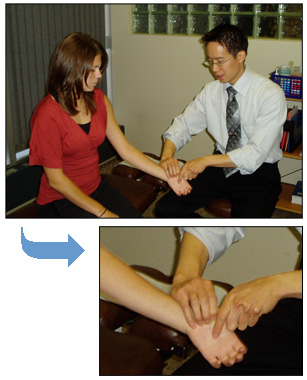 What is Carpal Tunnel Syndrome (CTS)?
What is Carpal Tunnel Syndrome (CTS)?
Carpal tunnel syndrome is a condition affecting the hand and wrist. Symptoms can also involve the forearm. It occurs when the median nerve becomes irritated or compressed in the carpal tunnel. This will result in pain, numbness, tingling, and weakness primarily in the thumb, index and middle finger, as well as the palm of the hand.
The median nerve originates from nerves in the neck and runs from the arm to the hand. It controls sensations to the palm side of the thumb and fingers (excluding the little finger). It also controls certain muscles in the hand.
The carpal tunnel is a space in the wrist. It is formed by the bones of the wrist and ligaments (band of tissues). Before entering the hand the median nerve must pass through the carpal tunnel.
CTS is often the result of a combination of factors that increase pressure on the median nerve in the carpal tunnel.
Factors that can contribute towards carpal tunnel syndrome
- Injury to the wrist (sprain, fracture)
- Tight forearm muscles
- Work stress
- Arthritis
- Fluid retention during pregnancy
- Diabetes
Carpal Tunnel Syndrome Symptoms
At first, symptoms commonly appear during the night. One may wake feeling the need to shake out the hand and wrist. These symptoms may be related to a bent position of the wrist while sleeping. When symptoms get worse, tingling, numbness, and pain may be felt throughout the day. Some may notice decreased strength in the hand, which makes it difficult to form a fist, grasp an object, or open a jar1. These same symptoms are felt when the median nerve is irritated or compressed in other parts of the arm.
Common treatment of Carpal Tunnel Syndrome
 The choice of treatment depends on the severity of the symptoms and any underlying illness, therefore it is important to get a proper diagnosis from a health professional. Treatment usually involves avoiding aggravating activities and resting the area for a few weeks and using a splint in order to avoid bent position of the wrist. If needed, ice, anti-inflammatories, or pain relievers can help for pain control and swelling1. When tolerated, stretching and strengthening should be included.
The choice of treatment depends on the severity of the symptoms and any underlying illness, therefore it is important to get a proper diagnosis from a health professional. Treatment usually involves avoiding aggravating activities and resting the area for a few weeks and using a splint in order to avoid bent position of the wrist. If needed, ice, anti-inflammatories, or pain relievers can help for pain control and swelling1. When tolerated, stretching and strengthening should be included.
Conservative treatment such as soft tissue therapy, chiropractic, and acupuncture can be beneficial to CTS sufferers.
In severe cases, surgery may be necessary if other modes of treatments have not eliminated or decreased the symptoms. “Surgery should not be the first choice for treatment”1.
How Active Release Technique (ART) can help resolve carpal tunnel syndrome?
Certain practitioners do not look beyond the actual carpal tunnel when testing or treating CTS. An ART practitioner in the United States found that the most common area of irritation or compression of the median nerve in individuals suffering from CTS symptoms was not at the carpal tunnel, but higher up in the forearm, due to a muscle called pronator teres.2 This shows the importance for the whole course of the median nerve to be assessed.
A chiropractor will use ART to successfully locate and remove adhesive restrictions (scar tissue) that compress and irritate the median nerve in the arm, wrist and hand. A chiropractor will also evaluate the neck and shoulder regions, which are other areas which may contribute to CTS symptoms.
- “Carpal Tunnel Syndrome Fact Sheet,” NINDS. Publication date November 2002.
- Leahy, Michael: Improved Treatments for Carpal Tunnel and Related Syndromes. Chiropractic Sports Medicine; Vol. 9, No. 1, 1995.

